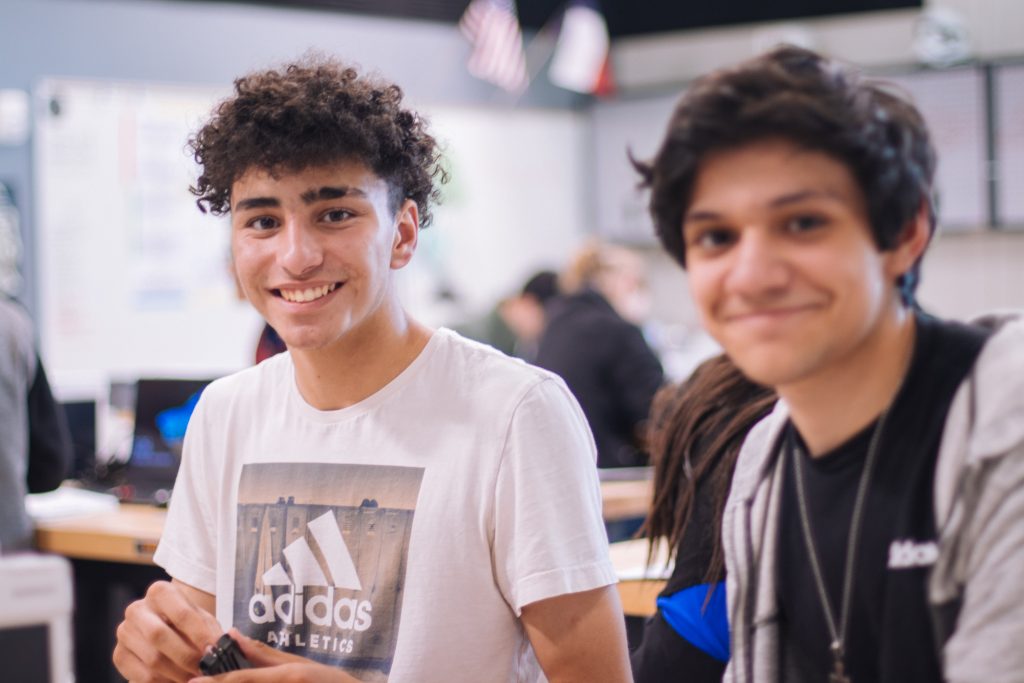How To Boost Your Child’s IQ and Balance In A World That Had Neither
09.07.2021

“Don’t let the noise of others’ opinions drown out your inner voice.”
Steve Jobs
Rarely has a quote been so timely. We are building a world that both tries to embrace diversity and profit from extremism. People now value opinions as a suitable alternative to common sense and provable facts.
Look at the political stage (if you can bear it). Watch critics question the value of higher education. The gap between rich and poor is widening, and the vulnerable fall prey to influencers peddling get-rich schemes on an alarmingly regular basis.
It is, in short, a complete mess. And it is this mess we’ll be handing over to our children.
No, these are not new phenomena. But the population of the vulnerable has increased. Are our children in danger of exposure to disruptive influences in a world where everyone’s an influencer?
Well, yes. But we can arm the next generation against these threats with critical analysis and the ability to process issues and discussions with 360-degree thinking. Your child deserves their own opinion, but they have to balance it using:
- Facts
- Personal experience with real-life examples
- A fully-formed belief system that can help them angle their opinions toward creating a better world
They’ll cement their worldview through school, internships, and their first job. These institutions and roles will help them push the boundaries of their critical thinking. But how do we make sure our children can separate the good influences from the destructive?
Team Vippi wants to help you equip your child for a world that wants to swallow them whole. They’re so impressionable – so we developed a system to help you manage how they process their impressions of the world.
Your child’s journey to critical thinking
For starters, what is critical thinking? Well, it’s the difference between answering a multiple choice question and making moral decisions. Critical thinking is more important than learning a language or musical instrument for your child’s development. It’s the foundation on which they’ll build their entire worldview.
You need to nurture critical thinking when a child is as young as possible. They’ll start developing a natural curiosity around the world when they begin to talk and form ideas. This curiosity will help their critical thinking skills blossom as they grow.
Did your child ever follow you around in their younger years while ceaselessly asking “why?” Then you’ve done a great job so far.
But this journey does not stop. We spend so much on our children going to college because it’s a 4-year critical thinking boot camp.
How do we inspire enhanced critical thinking when children are younger? There’s a four-step process that we can follow whenever we ask our children about a topic.
1. Transcend “What”
“What” questions tend to trigger reductive answers – direct responses that are a Google search away. Instead, add “how” and “why” to the equation.
The wrong way to ask: ⛔️
“What harmful effects does smoking have?”
The right questions to ask:
“How does smoking lead to its harmful effects?” ✅ This encourages children to move beyond the question and look at processes.
“Why should we avoid smoking?” ✅ This helps children make links between information and building a value system. They don’t just surmise that smoking causes lung cancer. They also make the link that this is bad for them.
“How might smoking affect this family if someone starts?” ✅ This brings the topic closer to home and encourages the child to think critically about how it might affect someone they know or love.
2. Check their process.
It’s not just what a child knows that’s important. Anyone can watch a YouTube video and regurgitate information. Being able to find evidence and reliable info will become central to their critical thinking skills.
The wrong way to follow up: “It’s great that you know this. You’re so clever.” ⛔️ Positive reinforcement is appropriate – sometimes. But when you’re trying to reinforce critical thinking, accepting their knowledge at face value won’t cut it.
The right way to follow up: “How did you find out that smoking causes lung cancer?” ✅ While you’re not expecting Harvard-style citations from your child just yet, being able to recount the process of how they found this information will reinforce an urge to research and support their viewpoints.
3. Make them aware of different perspectives.
Another key element of critical thinking is accounting for the viewpoints of others in your responses and solutions.
Make sure that when you’re asking your child questions, you position some of them in a way that encourages consideration for the perspectives of other people.
The wrong way to follow up:
“That’s right! All that matters is what you think.” ⛔️
The right way to follow up:
“How might smoking affect older people?” ✅ This encourages a child to think well beyond their age group. The consideration of long-term effects is a crucial aspect of critical thinking.
“Why would people in developing countries be hit particularly hard by smoking?” ✅ Inspire your child to think of cultures outside their own. This can help them develop a broader understanding of the world and consider topics on an international scale.
4. Encourage information synthesis.
We do believe the children are our future (thanks, Whitney). But they can’t solve the world’s ills at 11 years old.
However, we can start preparing them to become solution-driven thinkers. Asking “how can we make everyone stop smoking forever?” is mind-boggling. But breaking that down into more manageable chunks can help children take the information they’ve learned and apply it to practical knowledge.
It’s also essential to encourage more than one approach to a solution. This can help a child consolidate what they’ve learned.
The wrong way to follow up:
“It’s just going to be a problem forever. There’s no way to fix it.” ⛔️
The right way to follow up:
“How can we solve the way shops sell cigarettes?” ✅ This inspires your children to think about economic solutions to the problem.
“How can we teach people not to start smoking?” ✅ This may help them think about social and emotional approaches to the question.
“How can science help people quit?” ✅ Your child would need to dig into some research and find answers that way.
We doubt your child or children will come up with an answer to the tobacco industry overnight. What this process will reinforce, however, is the process of:
- Digging deeper to build a value system.
- Finding information in constructive ways.
- Considering the perspectives of others in their solutions.
- Applying their knowledge to practical measures.
Social media: A gift or a curse for children’s critical thinking?

You’d think that we’d try to keep our children as far away from social media as possible if we’re trying to exclude harmful influences from their lives.
But if you think social media is devoid of critical thinking benefits, you’re wrong. There are ways to leverage social media as a tool for developing constructive thought processes. It’s just about encouraging your child to be critical about their approach to social media and avoid just blindly absorbing whatever they read on there.
(It’s critical to protect your children from social media until they’re old enough – there are sharks in the water. But when they’re the right age, it can become a powerful tool for helping them process ideas and dialogue.)
How to use social media for critical thinking benefits
- It provides a social context for information. Twitter, for example, can help them link what they’re learning in History class to what’s going on right now. It can also help them understand that people have different responses to world events.
- It can serve as a model for intellectual tolerance. Okay, Twitter and Facebook clearly don’t show us the pinnacle of human decency and level-headedness. However, seeing completely different opinions fly around can help children absorb events and concepts without accepting or rejecting them. Use social media to teach them how to sit with new information, judgment-free.
- It lets children spread and discuss cognitive processes. When your child has an idea, it allows them to put that idea into the world for others to discuss. Seeing their idea in motion lets them break down how people use and respond to information in the real world. This shows them a link between their thoughts and other people’s actions.
- It drives a comparison between form and message. Children can learn that the medium a message takes (video, meme, tweet, or Facebook status, for example) can affect the content and meaning of the message itself. They must learn how to consider the limitations of a particular form of communication critically. This allows them to break through the medium and access the idea under consideration.
- It helps children break through their comfort zones. They may read opinions outside of their direct experience – and connect with them, too. As long as they know to question every belief they see, this is a healthy exercise. They might feel uncomfortable, but that’s okay.
Social platforms like Instagram, Facebook, and Twitter come with huge risks: predators and cyberbullies, for a start. They can also provide mind-numbing distractions that can suck time from your child’s day – thumbing through Instagram videos can take up valuable time they could have spent building their minds.
But they’ll find social media eventually, whether you try to protect them from its more malicious elements or not. Encourage them to use it analytically.
A framework of influence: What influences can nurture your children’s critical thinking powers?
You mustn’t only see your child’s developmental milestones in terms of “Wow! Jimmy rolled over today.” Various figures and factors in your child’s life will play a massive role in how their influences develop and will fuel their intelligence and balance moving forward.
Critical thinking milestones are also extremely important if you want your child to be able to approach the modern world with intelligence and emotional balance.
Team Vippi came up with the idea of a Framework of Influence – a way to manage how your child processes the influences in their lives without coddling them or shielding them from necessary information.
The Framework of Influence needs managing now so that your child can make informed, intelligent decisions about which influences to follow later in life.
Ironically, if you want your kid to be bright, you’ll have to manage their DIM. That’s:
- Dialogue
- Information sources
- Mentors
They’ll encounter each milestone more prominently as they grow.
Dialogue: The early years
When your child learns to form and understand sentences at around 18 months, your dialogue helps them work toward intelligent speech.
They’ll form words and sentences as most children do – but when will you encourage them to start developing ideas? When do you start asking the question “Why?” and inspiring curiosity? How long until they refuse to accept what they’re told at face value?
As you can read in the section above, there’s an established way to encourage critical thinking through dialogue. Make this a habit in your household – ”why” and “how” should become the norm.
This pattern of questioning needs to extend to their peer group, so make sure that when they’re with their friends, they continue to be inquisitive, show imagination, and question their friends’ actions and processes.
Information sources: Reading years
Your child will begin reading fluently by around 6 or 7 years. If you’ve successfully nurtured their minds during their dialogue milestone, they’ll be able to read information with an open mind.
However, this is the age they’ll encounter books, magazines, the Internet, YouTube Kids, and all types of materials they’ll take on board. As they’re just coming to terms with information, they’ll absorb it at an alarming rate.
How do you make sure the information they’re consuming is healthy for them? In this day and age, it’s not easy. Child locks on the internet can help, but that doesn’t guarantee they’ll access information that challenges them and forces them to think.
Ask the question
Ultimately, though, they can think about any media that crosses their path. So ask them about it – if you see them with a book or watching a cartoon, ask them questions like:
- What’s the main character’s goal?
- Why do they have that goal?
- How are they going about achieving that goal?
- Would you do the same in their situation? Why?
This questioning forces critical thinking even when the context is fictional. You can also ask what your child thinks of the book, always following up with that all-important Why?
The factual information they’ll absorb during childhood comes from school textbooks and educational materials, but these can be pretty sparse as fuel for critical thinking. They tell you what to think, not why. So make a point of collaborating with them on homework – not to give them the answers, but to inspire further thought and analysis.
“My science teacher told me today that penguins fire their poop more than a meter away!”
“That’s amazing. Why do you think that is?”
“Well, maybe it helps them keep their nests clean.”
“Most likely! How do you think that helps the penguins, then?”
“Well, I think it stops them from getting sick.”
Even a random, poop-based bit of information stood up to further analysis from your child. They can be encouraged to think about whatever they read.
Mentors: The socializing years
Eventually, your child will outgrow the sole focus of the dialogue and reading milestones and move into larger groups. They’ll spend more time at friends’ houses, in the company of their language and instrument tutors, and under the watchful eye of their sports coach.
With all of this socialization comes a new influence in your child’s life: their mentors. You will no longer be their only guiding light and the lens through which they digest information. The skills you’ve nurtured in them will be put to greater use developing their passions and interests.
The mentors in your child’s life won’t just be teaching them violin or football – they’ll be learning discipline, strategy, and perseverance. The qualities that help them retain intelligence and balance will become reinforced, and they’ll naturally be asking the “why” and “how” of every situation to gain a complete understanding.
With a mentor, they will have another adult perspective to absorb, challenge, and question. The guidance they receive may not align perfectly with your own, but it will significantly enhance their critical faculties.
Make sure you meet their coach, their favorite teacher, or the friend’s parent they look up to the most. You have to be sure they’re a constructive influence in your child’s life. Ask them what steps they take to nurture your child’s critical thinking alongside whatever skill they primarily teach or the company they provide.
While passing through these three milestones – Dialogue, Information sources, Mentorship –, your children will enter the wider world with a more balanced approach. They’ll know:
- How to talk about ideas
- How to question the information they read and form opinions on art
- How to absorb guidance from mentors – but not unquestioningly
The roundup
Your child won’t remain in a cocoon forever. You can’t protect them from all the harmful influences that will come their way throughout their lifetime – but you can provide them with the tools to decode information and ask questions.
Using the Team Vippi DIM system, you can guide your child through early life through various milestones that enable your child to move from the “whats” to the “hows” and “whys” of every influence they encounter. After all, we are parents too and this has been a simple and wonderful way in seeing the development of our children for the world that awaits them.
Article resources
Halton, M. (2019). Critical thinking is a 21st-century essential — here’s how to help kids learn it. https://ideas.ted.com/critical-thinking-is-a-21st-century-essential-heres-how-to-help-kids-learn-it/
Heick, T. (2017). 10 strategies to help students use social media for critical thinking. https://www.teachthought.com/pedagogy/10-strategies-help-students-use-social-media-critical-thinking/

















